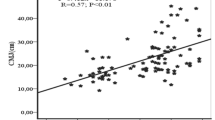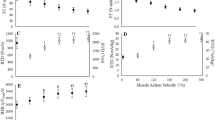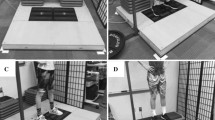Summary
Twenty-three girls and 19 boys performed the handgrip and standing long jump (SLJ) tests. Their total forearm and leg volumes were calculated from circumference and length measurements and the lean volumes (bone + muscle) were calculated by making allowance for skinfold thickness. Although the boys were older than the girls (12.8 and 12.4 years), there was no significant difference in their heights or body masses. The absolute performances of the boys were superior to those of the girls in both tests (handgrip 234 and 205 N and SLJ 1.53 and 1.34 m), but when jumping performance was expressed as distance x body mass, there was no significant difference. In both tests, performance in terms of unit lean limb volume showed no significant gender difference. When performance was related to lean limb volume, both boys and girls showed a linear relationship in the two tests, with no significant difference between them. This absence of a gender difference contrasts with the results of a previous study on young adults and comparison shows that the relationships between lean limb volume and performance in the two tests for both boys and girls lie just below those of the young, adult females. The difference between the girls and the young adult females was just significant in the handgrip (p<0.05), but not significant in the SLJ (p>0.25), whereas the differences between the boys and young adult males were significant (p<0.01) in both tests. Thus it would appear that a gender difference in the performance of skeletal muscle develops during adolescence and possible contributory factors are discussed.
Similar content being viewed by others
References
Blimkie CJR, Roache P, Hay JT, Bar-Or O (1988) Anaerobic power of arms in teenage boys and girls: relation to lean tissue. Eur J Appl Physiol 57:677–683
Cureton KJ, Boileau RA, Lohman TG (1975) Relationship between body composition measures and AAHPER test performances in young boys. Res Q 46:218–229
Davies BN, Greenwood EJ, Jones SR (1988) Gender difference in the relationship of performance in the handgrip and standing long jump tests to lean limb volume in young adults. Eur J Appl Physiol 58:315–320
Davies CTM, White MJ, Young K (1983) Muscle function in children. Eur J Appl Physiol 52:111–114
Ellis JD, Carron AV, Bailey DA (1975) Physical performance in boys from 10 through 16 years. Hum Biol 47:263–281
Eppenschade AS (1963) Restudy of relationships between physical performances of school children and age, height, and weight. Res Q 34:144–153
Eppenschade AS, Meleney HE (1961) Motor performances of adolescent boys and girls of today in comparison with those of 24 years ago. Res Q 32:186–189
Jones PRM, Pearson J (1969) Anthropometric determination of leg fat and muscle plus bone volumes in young male and female adults. J Physiol 204:63–66P
Jones DA, Parker DF, Round JM, Sacco P (1989a) Muscle strength in boys during childhood and adolescence. J Physiol 409:15 P
Jones DA, Parker DF, Round JM, Sacco P (1989b) Muscle strength in girls during childhood and adolescence. J Physiol 415:124 P
Katch V, Weltman A (1975) Predictability of body segment volumes in living subjects. Hum Biol 47:203–218
Montoye HJ, Lamphiear DE (1977) Grip and arm strength in males and females, age 10 to 69. Res Q 48:109–120
Schantz P, Randall-Fox E, Hutchinson W, Tyden A, Astrand P-O (1983) Muscle fibre type distribution, muscle cross-sectional area and maximal voluntary strength in humans. Acta Physiol Scand 117:219–226
Slaughter MH, Lohman TG, Misner JE (1977) Relationship of somatotype and body composition to physical performance in 7–12 year-old-boys. Res Q 48:159–168
Slaughter MH, Lohman TG, Misner JE (1980) Association of somatotype and body composition to physical performance in 7–12 year-old girls. J Sports Med 20:189–198
Slaughter MH, Lohman TG, Boileau RA (1982) Relationship of anthropometric dimensions to physical performance in children. J Sports Med 22:377–385
Telford RD, Ellis LB, Ashton JJ, Rich PA, Woodman LR (1986) Anthropometric, physiological and performance characteristics of 12-year-old boys and girls — should they co-compete? Aust J Sci Med Sport 18:20–24
Zavaletta AN, Malina RM (1982) Growth and body composition of Mexican-American boys 9 through 14 years of age. Am J Phys Anthropol 57:261–271
Author information
Authors and Affiliations
Rights and permissions
About this article
Cite this article
Davies, B.N. The relationship of lean limb volume to performance in the handgrip and standing long jump tests in boys and girls, aged 11.6–13.2 years. Europ. J. Appl. Physiol. 60, 139–143 (1990). https://doi.org/10.1007/BF00846034
Accepted:
Issue Date:
DOI: https://doi.org/10.1007/BF00846034




